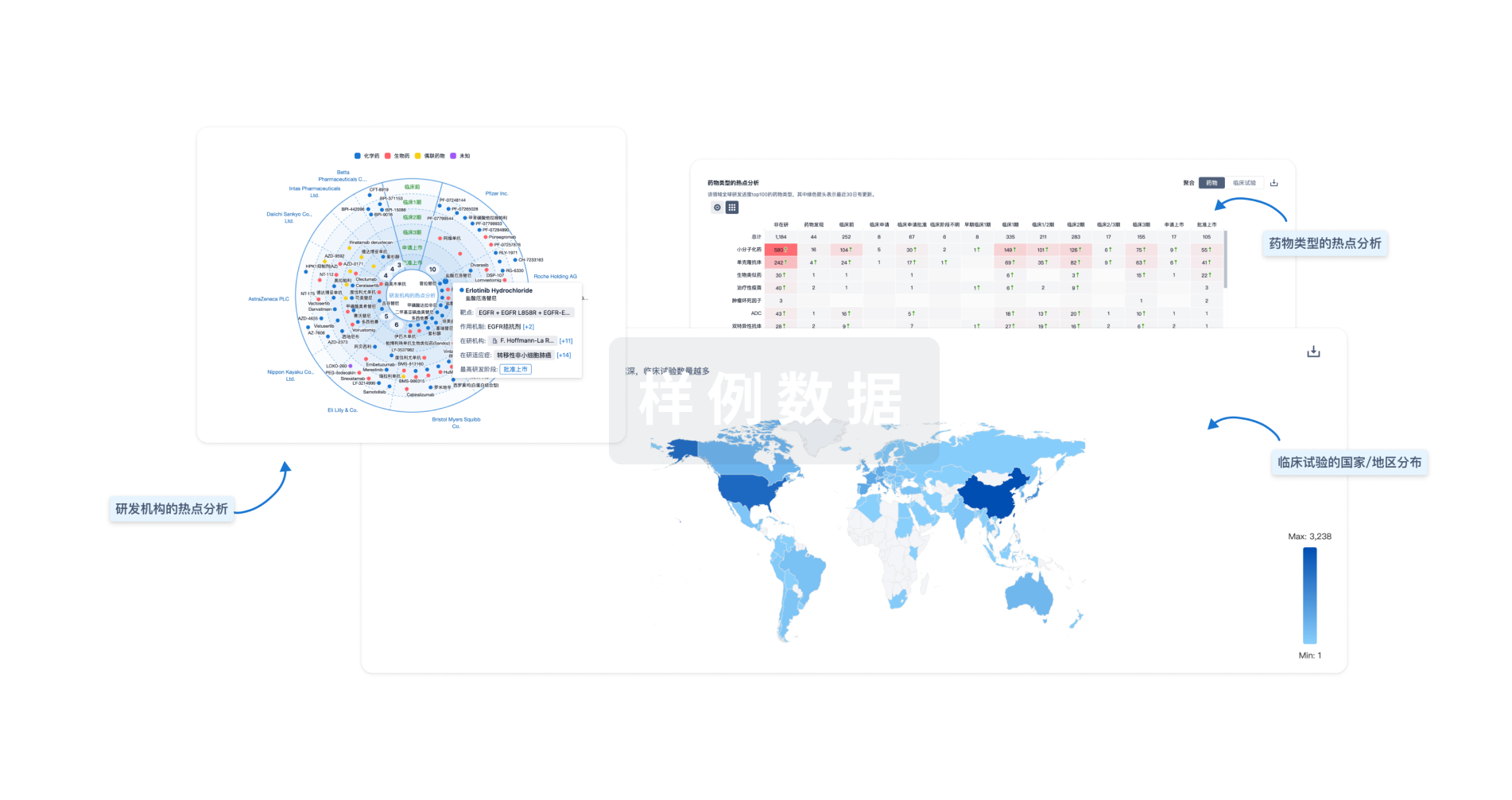预约演示
更新于:2025-05-07
Menopausal syndrome
更年期综合症
更新于:2025-05-07
基本信息
别名 Climacteric syndrome、MENOPAUSAL DISORDER、MENOPAUSAL SYNDROME + [26] |
简介 A grouping of variable physical, vasomotor and psychological symptoms in climacteric females. Physical symptoms include: cessation of menses, headaches, fatigue, weight gain and vaginal dryness. Vasomotor symptoms typically include: palpitations, hot flashes and night sweats. Psychological symptoms may include: decrease in libido, emotional lability, difficulty concentrating and insomnia. |
关联
69
项与 更年期综合症 相关的药物靶点- |
作用机制- |
在研机构 |
原研机构 |
在研适应症 |
非在研适应症- |
最高研发阶段批准上市 |
首次获批国家/地区 中国 |
首次获批日期2021-11-24 |
靶点- |
作用机制- |
在研机构 |
原研机构 |
在研适应症 |
非在研适应症- |
最高研发阶段批准上市 |
首次获批国家/地区 中国 |
首次获批日期2020-04-24 |
381
项与 更年期综合症 相关的临床试验NCT06580470
Improving Functioning Among Aging Women Veterans With Major Mental Illness
Women are the fastest-growing group of U.S. Veterans. Over half of those using VA care are 45 or older, with more age-related health concerns than civilian women. The VA urgently needs gender-informed strategies to ensure women Veterans receive tailored care that addresses their intersecting mental, physical, and age related health concerns, as well as gender-linked stressors. One prominent example is menopause, a health transition period that, for many women, can be associated with negative physical and mental health concerns that can worsen their functioning and quality of life. This project will: (1) integrate stakeholder feedback to tailor Cognitive Behavioral Therapy for Menopause (CBT-Meno) for women Veterans with menopause concerns; and (2) refine and evaluate tailored CBT-Meno as a treatment to address these intersecting needs in a clinical trial.
开始日期2026-12-01 |
NCT06318403
Estradiol Supplementation and Rotator Cuff Repair: A Preliminary Randomized Trial
Rotator cuff tears in the shoulder are common causes of pain and disability, often fail to heal with surgery, and tears, worse outcomes after surgery, and failure of healing are associated with estradiol deficiency. In this study, post-menopausal women will be randomized to either estradiol patches or placebo patches after repair of the rotator cuff. The purpose of this study is to determine whether estradiol patches show promise in improving shoulder pain, strength, muscle volumes, and function when given with rotator cuff repair.
开始日期2026-03-01 |
申办/合作机构 |
NCT06192329
Hot Water Therapy for the Treatment of Menopause-related Hot Flashes and Other Symptoms: a Clinical Trial
The purpose of this research is to determine whether hot water therapy (i.e. taking prolonged hot baths on multiple consecutive days) decreases hot flash symptoms and improves mood in women who are undergoing or who have underwent menopause. It is hypothesized that women who undergo hot water therapy will have reduced hot flash symptoms and improved mood.
Initial tracking period: Women who volunteer to participate in this study will be asked to track the frequency and intensity of their hot flash and other menopause-related symptoms for an initial two week period. Afterwards, they will start their heat therapy program.
Physiological assessments: On days 1, 7, and 13 of the heat therapy sessions, the participants will enter a climate controlled room to have their thermoregulatory responses assessed. This will consist of slowly walking on a motorized treadmill in 99.5°F (37.5°C) and 30% relative humidity conditions, for 30 min, after which the humidity in the climate chamber will be progressively increased until their core temperature begins to increase (
2 hour total time). Before and/or during these trials, core temperature, heart rate, whole-body sweat losses, thermal comfort, local sweat rate, and skin blood flow will be measured, and a 6 ml (
1 tsp) blood sample will be taken, to assess how the participants respond to the heat stress. These sessions should take less than 3 hours to complete.
Hot water therapy sessions: Upon enrolling in the study, the participants will be assigned to one of two groups: water bathing at 105°F or 97°F in the lab. On days 2-6 and 8-12 of the therapy sessions, the participants will immerse themselves to a water level at the shoulders for
30 min, followed by immersion to the hip level for
60 min (total immersion time of 90 min).
Post-intervention tracking period: after completing the heat therapy sessions, the participants will be asked to continue to take baths at home once every 4 days for 1 month. During this time, the participants will be asked to record the intensity and frequency of their hot flashes daily and other menopause-related symptoms weekly. At the end of this month the participants will be given a final exit survey, in order for them to provide the researchers information about their experience participating in the study.
Initial tracking period: Women who volunteer to participate in this study will be asked to track the frequency and intensity of their hot flash and other menopause-related symptoms for an initial two week period. Afterwards, they will start their heat therapy program.
Physiological assessments: On days 1, 7, and 13 of the heat therapy sessions, the participants will enter a climate controlled room to have their thermoregulatory responses assessed. This will consist of slowly walking on a motorized treadmill in 99.5°F (37.5°C) and 30% relative humidity conditions, for 30 min, after which the humidity in the climate chamber will be progressively increased until their core temperature begins to increase (
2 hour total time). Before and/or during these trials, core temperature, heart rate, whole-body sweat losses, thermal comfort, local sweat rate, and skin blood flow will be measured, and a 6 ml (
1 tsp) blood sample will be taken, to assess how the participants respond to the heat stress. These sessions should take less than 3 hours to complete.
Hot water therapy sessions: Upon enrolling in the study, the participants will be assigned to one of two groups: water bathing at 105°F or 97°F in the lab. On days 2-6 and 8-12 of the therapy sessions, the participants will immerse themselves to a water level at the shoulders for
30 min, followed by immersion to the hip level for
60 min (total immersion time of 90 min).
Post-intervention tracking period: after completing the heat therapy sessions, the participants will be asked to continue to take baths at home once every 4 days for 1 month. During this time, the participants will be asked to record the intensity and frequency of their hot flashes daily and other menopause-related symptoms weekly. At the end of this month the participants will be given a final exit survey, in order for them to provide the researchers information about their experience participating in the study.
开始日期2025-12-01 |
申办/合作机构 |
100 项与 更年期综合症 相关的临床结果
登录后查看更多信息
100 项与 更年期综合症 相关的转化医学
登录后查看更多信息
0 项与 更年期综合症 相关的专利(医药)
登录后查看更多信息
2,017
项与 更年期综合症 相关的文献(医药)2025-12-31·Gynecological Endocrinology
Hormone therapy with different administration routes for patients with perimenopausal syndrome: a systematic review and network meta-analysis
Review
作者: Luo, Xinrui ; Ren, Mulan ; Wang, Yan ; Wang, Liping
2025-06-01·Regenerative Therapy
Amelioration of female menopausal syndrome by intravenous administration of autologous menstrual blood-derived stem cells
Article
作者: Hisanaga, Ichiro ; Yoshimoto, Takayuki ; Izawa, Hiromi ; Ogawa, Seiji ; Xiang, Charlie
2025-06-01·Fitoterapia
In silico molecular docking and predictive ADME properties, in vitro antioxidant scavenging capacities, and in vivo pharmacological activities to study the potential of Pterocarpus mildbraedii's Harms (Fabaceae) in preventing vaginal dysbiosis and risk factors for cardiovascular disease in an estropause rat model
Article
作者: Carlos, Tcheutchoua Yannick ; Sandrine, Mengue Ngadena Yolande ; Ngo Bahebeck, Pierrette ; Cynthia, Bouguem Yandja Paule ; Bibi-Farouck, Aboubakar Oumarou ; Michel, Bindzi Georges ; Désiré, Dzeufiet Djomeni Paul ; Emmanuel, Owona Pascal ; Ulrich, Ngueuko Talla Jude ; Bidingha A Goufani, Ronald ; Dupon, Ambamba Akamba Bruno ; Claude, Bilanda Danielle ; Fils, Ella Armand
96
项与 更年期综合症 相关的新闻(医药)2025-04-23
WHI ran the estrogen plus progestin trial, which proved that a common hormone therapy used to treat menopause increased the risk of coronary heart disease and breast cancer.\n The Department of Health and Human Services (HHS) is cutting off funding to the long-running Women’s Health Initiative (WHI) in September, a move that leaves the fate of one of the world\'s largest women’s health studies hanging in the balance.The agency is canceling contracts to the WHI’s regional centers by the end of September, the WHI said in an April 21 announcement. The initiatives’ coordinating center, housed at the Fred Hutchinson Cancer Center in Seattle, will continue running until January 2026, after which “its funding remains uncertain,” according to the announcement.At the time of publication, the HHS and Fred Hutchinson Cancer Center had not responded to Fierce\'s request for comment.WHI regional centers are spread across the country at locations in New York, Massachusetts, Ohio, North Carolina, California and Washington.The original WHI study began in 1991 with funding from the NIH’s National Heart, Lung and Blood Institute. The study enrolled 161,808 women between the ages of 50 and 79, investigating strategies to prevent heart disease, osteoporosis and breast and colorectal cancer.After the initial study wrapped in 2005, the initiative has continued through multiple extension studies that follow original study participants, with more than 42,000 women still involved. Scientists associated with WHI have published more than 2,400 scientific papers and tracked tens of thousands of cancer cases, cardiovascular events and deaths, according to the recent announcement. One of WHI’s signature discoveries came from the estrogen plus progestin trial, which proved that a common hormone therapy used to treat menopause can increase the risk of coronary heart disease and breast cancer. The evidence of the therapy’s dangers was so strong that the trial was halted three years early. The WHI says the release of the findings prevented an estimated 126,000 breast cancer cases and 76,000 cardiovascular disease cases over the following decade, representing $35.2 billion saved in direct medical costs.Since then, WHI scientists have broadened their remit to a number of other age-related health issues, including frailty, vision loss, dementia, mental health and social isolation, according to the announcement.The Trump administration’s canceling of women’s health funding stands in stark contrast to that of his predecessor. Former President Biden launched a women’s health effort in November 2023, helmed by former First Lady Jill Biden, and asked Congress for $12 billion to fund research on diseases that commonly affect women like rheumatoid arthritis, menopause, Alzheimer’s disease and endometriosis.

临床研究
2025-04-20
·汇聚南药
在日常生活中,老年人可能会遇到各种各样的健康问题,如头痛、胃痛、失眠、疲劳等。面对这些问题,许多老年人寻求各种方法来改善健康状况。而谷维素,这种几块钱一瓶的“神奇”药物,或许能为老年人带来意想不到的健康益处。谷维素的药理作用,不可不知谷维素是从米糠中提取的天然混合物,所以又称“米糠素”,是以三萜醇(烯)为主体的阿魏酸酯混合物。其具有两大功能:1、自主调节神经功能:谷维素能减少分泌平衡障碍,改善精神心理失调症状,稳定情绪、减轻焦虑及紧张状态,可以改善睡眠。2、调节间脑功能:谷维素激活与自主神经相关的下丘脑及大脑边缘系统。现代人饮食精细,吃的都是精制大米、精白面粉等“细粮”。在精加工的过程中,谷皮、糊粉层和胚芽被去除,导致谷维素、膳食纤维及B族维生素等天然营养素大量流失。除了糙米、全麦、玉米、青稞、高粱等全谷物,芸豆、绿豆等杂豆类、山药、芋头等块茎类,都属于粗粮。日常可以多吃一些。《中国居民膳食指南》推荐:健康成年人每天应摄入谷类食物200~300g。其中全谷物和杂豆类50~150g; 薯类50~100g。如果你有以下五种情况之一,可能意味着「植物神经功能紊乱」,需要额外补充谷维素了。谷维素:五类疾病常用谷维素主要作用于间脑的植物神经系统与分泌中枢,从而改善和调节植物神经功能失调、内分泌平衡障碍及精神失调等症状。1、焦虑、失眠老年人常常面临失眠的问题,这可能与植物神经功能紊乱有关。谷维素能够调节自主神经系统,减少内分泌平衡障碍,从而改善精神神经失调症状。对于轻中度的失眠,谷维素具有很好的疗效,尤其对中老年人因植物神经功能紊乱所引起的失眠具有明显效果。老年人可以在医生指导下,将谷维素与维生素B1或安神补脑液搭配使用,以改善睡眠质量。2、胃肠神经官能症如果你情绪紧张时容易腹痛、腹胀,或腹泻、便秘交替出现,伴随食欲减退、餐后饱胀感,做了胃肠检查却显示一切正常。可能是胃肠神经官能症。除了应用谷维素之外,还可以辨证搭配香砂养胃丸、参苓白术丸、保和丸等中成药以增强疗效。3、心脏神经官能症出现心悸、胸闷、心前区短暂刺痛或隐痛,伴有焦虑、多汗、乏力,但是心电图、冠脉CT、心脏彩超等专业心脏检查显示无器质性异常时,多考虑心脏神经官能症。也可以通过补充谷维素来缓解症状。辨证搭配生脉饮、稳心颗粒、参松养心胶囊等中成药效果更佳。4、经前期综合征有些女性的朋友在来月经之前会出现烦躁、焦虑、乳房胀痛、头痛、恶心呕吐、食欲不振、水肿等表现。这类症状统称为“经前期综合征”。补充一点谷维素也能缓解。辨证搭配乌鸡白凤丸、柴胡疏肝丸、逍遥丸等中成药效果更佳。5、更年期综合征一到更年期,特别容易出现焦虑、急躁、易怒、心悸失眠、潮热盗汗等一系列症状。此时也可以尝试补充谷维素。同时,还可辨证应用坤泰胶囊、更年安颗粒、坤宝丸、灵莲花颗粒等中成药。此外,不少现代研究证明,谷维素还有辅助降血脂、减轻心绞痛、治疗多发性口腔溃疡、治疗小儿异食癖等多种作用。谷维素的用药禁忌,不可不记1、特殊人群不宜服用:胃及十二指肠溃疡者,不宜服用谷维素。2、可能出现不良反应:服用谷维素后,偶有患者出现胃部不适、恶心、呕吐、口干、疲乏、皮疹、乳房胀痛、油脂分泌过多、脱发、体重增加等不良反应,停药后症状可消失。3、注意服用体位:不可躺着服用谷维素,因谷维素容易黏附食道,刺激食道壁。服药期间,不要进食辛辣刺激食物。服用谷维素有讲究谷维素作为一种天然提取物,其安全性已获广泛认可。说明书推荐谷维素日剂量为10mg~60mg,满足日常养护需求。但研究显示,为获更显著益处,可能需更大剂量。针对老年人,结合个人状况及专业评估,剂量可调整至300mg~600mg。为减少副作用风险,建议分次服用,并密切关注大剂量用药的副作用及实际效益。谷维素建议饭后服用,以促进吸收并减少胃肠刺激。与维生素E、辅酶Q10等亲脂性抗氧化剂联合使用,可发挥协同作用,增强效果。谷维素以其多样的生物活性,在老年健康管理中展现巨大潜力,合理补充有助于缓解慢性疾病症状,延缓衰老,提升生活质量。未来,谷维素在老年健康领域的应用前景将更加广阔。来源丨医护多药学学霸综合整理 喜欢我们文章的朋友点个“在看”和“赞”吧,不然微信推送规则改变,有可能每天都会错过我们哦~免责声明“汇聚南药”公众号所转载文章来源于其他公众号平台,主要目的在于分享行业相关知识,传递当前最新资讯。图片、文章版权均属于原作者所有,如有侵权,请在留言栏及时告知,我们会在24小时内删除相关信息。信息来源:医护多药学学霸往期推荐本平台不对转载文章的观点负责,文章所包含内容的准确性、可靠性或完整性提供任何明示暗示的保证。
2025-04-17
关注并星标CPHI制药在线4月9日,CDE官网显示,宝仁堂药业自主研发的1.1类创新中药“三贝苎鼾胶囊”的上市申请获受理。三贝苎鼾胶囊是宝仁堂药业依据祖传治疗“鼾症”的配方进行自主研发的中药,用于治疗阻塞性睡眠呼吸暂停(OSA)。2024年12月,该药治疗阻塞性睡眠呼吸暂停低通气综合征(痰瘀互结证)的多中心、随机、双盲、安慰剂平行对照3期临床试验总结会成功召开。结果显示:三贝苎鼾胶囊治疗OSA疗效显著,可明显降低呼吸暂停低通气指数(AHI),提高应答率,且药物安全性良好。OSA指患者在睡眠过程中反复出现呼吸暂停和低通气,临床表现为打鼾,鼾声大且不规律,夜间窒息感或憋醒,睡眠紊乱,白天出现嗜睡,记忆力下降,严重者出现认知功能下降,行为异常。据美国睡眠医学会估计,2025年全球OSA患病人数将增加到11.6亿。我国的OSA患者人数居全球首位,其次是美国、巴西和印度。目前,OSA的治疗手段主要包括危险因素控制(如饮食控制、加强锻炼)、体位治疗(无创气道正压通气治疗)、口腔矫治和外科手术治疗。2024年12月,FDA批准首款OSA直接治疗药物Zepbound(tirzepatide)。该药是全球首款获批上市的GLP-1/GIP双重受体激动剂,被FDA批准用于治疗中重度OSA合并肥胖症成人患者,且还被批准用于降糖和减重。此外,目前全球还有多款在研OSA新药,如AD109(Apnimed,3期临床)、IHL-42X(Incannex,2/3期临床)、THX-110(SciSparc,2期临床)、BIOS-0618(百诚医药,获批临床)。AD109是一种包含具选择性的去甲肾上腺素再摄取抑制剂托莫西汀与抗毒蕈碱aroxybutynin的组合配方,通过靶向OSA关键的神经通路,活化上呼吸道扩张肌,使得患者在睡眠时仍可维持呼吸道的畅通。AD109治疗OSA的2b期临床试验MARIPOSA结果显示:与安慰剂相比,AD109组患者的呼吸暂停低通气指数(AHI4,呼吸不足定义为4%饱和度降低)降低45%,达到主要研究终点。而且,2.5/75 mg AD109组患者在PROMIS疲劳量表(该量表测量日间疲劳程度及OSA对日常活动的影响)上表现出统计学显著改善。AD109使用方便,每天仅需睡前口服一次,曾被FDA授予快速通道资格。IHL-42X是屈大麻酚和乙酰唑胺的组合,已完成2期概念验证临床试验结果显示:与基线相比,使用低剂量 IHL-42X,患者AHI减少50.7%。此外,IHL-42X还能够改善患者的睡眠质量。THX-110是基于大麻素的创新药物之一,由屈大麻酚和大麻素棕榈酰乙醇酰胺组合而成。人的大脑和免疫系统中存在有大麻素受体,THX-110旨在刺激中枢神经系统的大麻素受体,抑制内源性大麻素的代谢降解,提高四 氢 大 麻 酚的吸收。 中药新药大爆发2025第一季度批准8款在国家大力发展中医药创新的背景下,我国中药市场持续向好,中药创新也进一步加速。据悉2024年NMPA共批准12个中药新药,其中包括3个1.1类中药复方制剂(即儿茶上清丸、九味止咳口服液和秦威颗粒),8个3.1类按古代经典名方目录管理的中药复方制剂(即芍药甘草颗粒、苓桂术甘颗粒、温经汤颗粒、当归补血汤颗粒、二冬汤颗粒、一贯煎颗粒、枇杷清肺颗粒)和1个3.2类其他来源于古代经典名方的中药复方制剂(即温阳解毒颗粒)。2025年中药新药获批数量有望再攀新高。据悉,2025年第一季度NMPA已批准8款中药新药(详见下表),其中包括2款1.1类中药复方制剂。此外,截至2025年4月10日,据CDE官网,已有17款中药新药申请上市(详见下图),其中包括4款1.1类新药,即宝仁堂药业的三贝苎鼾胶囊(治疗阻塞性睡眠呼吸暂停)、以岭药业的芪桂络痹通片(治疗类风湿关节炎)、康缘药业的六味地黄苷糖片(治疗更年期综合征)和天士力的安神滴丸(治疗失眠症)。仅从2025年第一季度批准以及报产的中药新药来看,我国中药新药进入收获期,且覆盖的适应症愈发广泛。期待在利好政策的加持下,我国中药新药在人类抗击疾病的历史上更佳灿烂辉煌。END2025金笔奖征文即将截止,速来投稿!领取CPHI & PMEC China 2025展会门票智药研习社课程预告来源:CPHI制药在线声明:本文仅代表作者观点,并不代表制药在线立场。本网站内容仅出于传递更多信息之目的。如需转载,请务必注明文章来源和作者。投稿邮箱:Kelly.Xiao@imsinoexpo.com▼更多制药资讯,请关注CPHI制药在线▼点击阅读原文,进入智药研习社~
快速通道临床3期临床2期临床结果上市批准
分析
对领域进行一次全面的分析。
登录
或

生物医药百科问答
全新生物医药AI Agent 覆盖科研全链路,让突破性发现快人一步
立即开始免费试用!
智慧芽新药情报库是智慧芽专为生命科学人士构建的基于AI的创新药情报平台,助您全方位提升您的研发与决策效率。
立即开始数据试用!
智慧芽新药库数据也通过智慧芽数据服务平台,以API或者数据包形式对外开放,助您更加充分利用智慧芽新药情报信息。
生物序列数据库
生物药研发创新
免费使用
化学结构数据库
小分子化药研发创新
免费使用





